Fr. Polynesia Flora
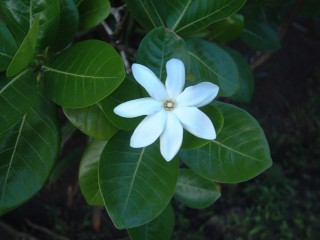 The plants in French Polynesia come from many parts of the
world. When the earliest human migrants arrived in what is today the
Society
Islands of French Polynesia,
they found volcanic islands whose steep slopes were covered mostly in ferns. Along the
shores grew luxuriant vegetation, but only two flowering plants: the tiare (below), a
species of gardenia, and the pua.
The plants in French Polynesia come from many parts of the
world. When the earliest human migrants arrived in what is today the
Society
Islands of French Polynesia,
they found volcanic islands whose steep slopes were covered mostly in ferns. Along the
shores grew luxuriant vegetation, but only two flowering plants: the tiare (below), a
species of gardenia, and the pua.
The food crops that are so prolific today were all imported, first by the
Maori peoples themselves who brought coconut palms, mape (Tahitian chestnut),
breadfruit trees, and the yam.
Migrants stopping in New Guinea brought with them fe'i and me'i bananas and the auti,
a plant whose root contains 20% sugar.
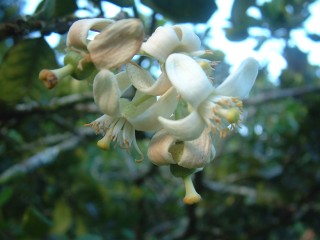 In the mid-1800's an English surgeon living in Tahiti introduced cocoa trees,
mimosas, mandarins, jasmine, Bougainvillea, and hibiscus.
Other settlers and
seafarers of the same era brought lantana plants and plumeria (frangipani). Many
other food crops were introduced in the late 1880's by a French pharmacist in
the Marines who had been charged with introducing productive plants to French
Polynesia.
He created a garden with 1500 plants including bamboos, eucalyptus,
rubber, and traveler's palm trees. He is credited with bringing vanilla to the
islands as well, now a major cash crop.
The last great importer of plants was an
eccentric American, Harrisson Smith, who created a garden with over 250 new
species including beautiful ones like the flamboyant trees, and fruit trees such
as the local pamplemousse, or grapefruit.
In the mid-1800's an English surgeon living in Tahiti introduced cocoa trees,
mimosas, mandarins, jasmine, Bougainvillea, and hibiscus.
Other settlers and
seafarers of the same era brought lantana plants and plumeria (frangipani). Many
other food crops were introduced in the late 1880's by a French pharmacist in
the Marines who had been charged with introducing productive plants to French
Polynesia.
He created a garden with 1500 plants including bamboos, eucalyptus,
rubber, and traveler's palm trees. He is credited with bringing vanilla to the
islands as well, now a major cash crop.
The last great importer of plants was an
eccentric American, Harrisson Smith, who created a garden with over 250 new
species including beautiful ones like the flamboyant trees, and fruit trees such
as the local pamplemousse, or grapefruit.
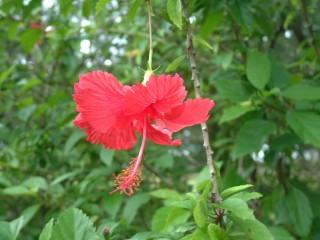 Today, a stroll down any village street in the Tuamotus,
Marquesas, or Society Islands is like walking through a tropical garden. The
French Polynesians keep immaculate yards, raked and swept daily. On the small
islands, the garden refuse is burned. On the larger islands piles of yard
sweepings can be seen lying by the road ready for pick up by the island refuse
trucks.
Today, a stroll down any village street in the Tuamotus,
Marquesas, or Society Islands is like walking through a tropical garden. The
French Polynesians keep immaculate yards, raked and swept daily. On the small
islands, the garden refuse is burned. On the larger islands piles of yard
sweepings can be seen lying by the road ready for pick up by the island refuse
trucks.
|
On the steep forested slopes of Moorea, Tahiti, Huahine and Raiatea
the Tahitian chestnut, also known as the mape, grows to over 100 feet.
It is characterized by its fluted shape, expanding to creeping roots,
similar to a ficus tree. The pin-pong ball sized chestnuts are edible
when roasted, but we never got to try any. |
 |
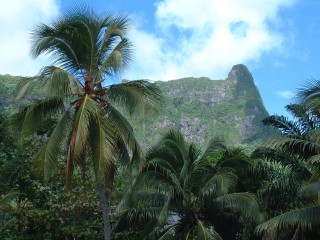 |
A thousand years ago there were no coconut palms in
Tahiti. Today, coconuts (left) are commercially grown on all the islands, the
meat dried to create copra which is used in soaps, perfumes, and
cosmetics. The fresh nut supplies water, milk and edible pulp. The heart
is used in salads. The trunk can be used for building wood and the
fronds for woven mats. |
 |
| The noni plant (right) is a newer commercial venture in the
islands. Most noni fruits are sent to Utah where they are processed into
medicines, shampoos, and skin aids. The Polynesians use the viscous
squeezings for shampoo and digestive aids. |
| The flowers of the ixora (Rubiaceae) can be either
red, pink, white or yellow. These clusters can be up to 8 or 9 inches
across. Introduced from Indonesia, this is now a common ornamental
throughout the S. Pacific and the Caribbean. |
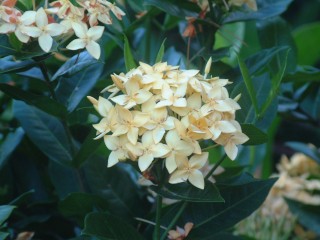 |
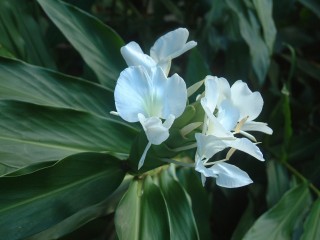 |
Two members of the ginger family (left and right), with very different
flowers. On the left, the Butterfly Ginger is sweetly pungent. In the
evening the flower is especially fragrant, giving it its Latin genus
name Hedychium, the Greek for "sweet snow". The
Red, or Torch Ginger (right) originates in Malaysia, but is now
widespread throughout the tropics. The plants display tall red flowers
without fragrance almost year-round. |
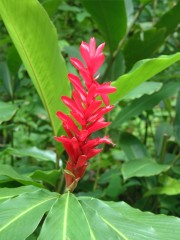 |
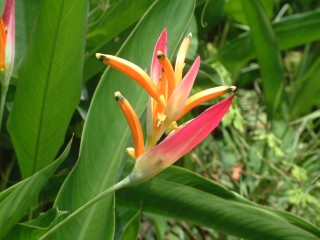 |
A member of the banana family, this unusual heliconia (left) is call the Parrot's
Plantain because of its exotic inflorescence. It comes from Guayana and Brazil,
and grows up to 1 meter high. |
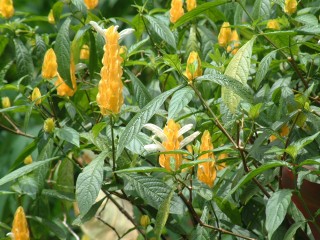 |
| The Pachystachys plant (right) is known for its bright yellow
heart-shaped bracts arranged precisely in four rows. The small white
flowers are not shown here, but extend
from the axils of the bracts, with a distinct upper and lower lip. this
is originally from the American tropics. |
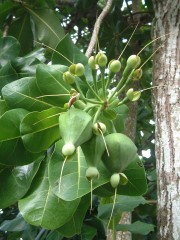
|
Mary
(right) is holding the flower and seed pod of the
"Shaving Brush" tree, so named for the feathery flowers which spring forth in bright
pink. This one was on the shores of Moorea. |
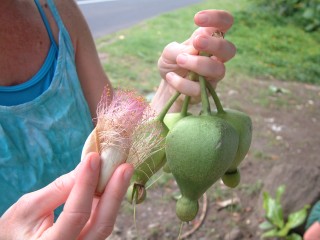 |
 |
One of our favorite tropical trees with fragrant flowers is the
frangipani, or plumeria (left). The flowers can be white and yellow,
like this one, or a rich pink and orange. In French Polynesia they are
commonly worn in the hair or made into flower necklaces. |
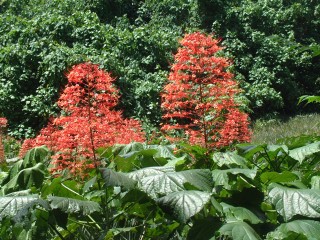 |
| This showy Clerodendron (right) called the Pagoda Plant, is a
native of SE Asia. We found it growing along roadside gardens and in
the horticultural college grounds on Moorea. |
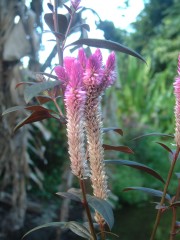 |
Two more glorious tropical flowers (left and right). We have no ID for
the one of the left which we saw at the Botanical Garden in Raiatea. The
tree on the right is known to us from the Caribbean, but we no
longer have the ID book aboard to find its name! |
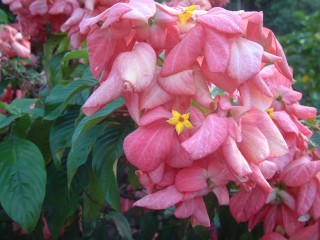 |
Up
Fr. Polynesia Home | Marquesas Letters | Tuamotus Letters | Diving | Polynesia Flora/Fauna | S Pacific Cruising
West Indies Flora/Fauna | Venezuela Flora/Fauna | SW Caribbean Flora/Fauna | Galapagos Flora/Fauna | Fr. Polynesia Flora/Fauna | Tonga & Fiji Flora/Fauna | Australia Flora/Fauna | Southeast Asia Flora/Fauna | Sri Lanka Flora/Fauna | Madagascar Flora/Fauna | Marine Mammals
Top Level:
Home |
Destinations |
Cruising Info |
Underwater |
Boat Guests |
Ocelot |
Sue |
Jon |
Amanda |
Chris |
Site Map |
Make a Comment
 |
Lifetime
Commodores
of the
Seven Seas
Cruising
Association |
 |
|
If our information is useful,
you can help by making a donation
|
Copyright © 2000‑ Contact:
Jon and Sue Hacking -- HackingFamily.com, svOcelot.com.
All rights reserved.
 The plants in French Polynesia come from many parts of the
world. When the earliest human migrants arrived in what is today the
Society
Islands of French Polynesia,
they found volcanic islands whose steep slopes were covered mostly in ferns. Along the
shores grew luxuriant vegetation, but only two flowering plants: the tiare (below), a
species of gardenia, and the pua.
The plants in French Polynesia come from many parts of the
world. When the earliest human migrants arrived in what is today the
Society
Islands of French Polynesia,
they found volcanic islands whose steep slopes were covered mostly in ferns. Along the
shores grew luxuriant vegetation, but only two flowering plants: the tiare (below), a
species of gardenia, and the pua. In the mid-1800's an English surgeon living in Tahiti introduced cocoa trees,
mimosas, mandarins, jasmine, Bougainvillea, and hibiscus.
Other settlers and
seafarers of the same era brought lantana plants and plumeria (frangipani). Many
other food crops were introduced in the late 1880's by a French pharmacist in
the Marines who had been charged with introducing productive plants to French
Polynesia.
He created a garden with 1500 plants including bamboos, eucalyptus,
rubber, and traveler's palm trees. He is credited with bringing vanilla to the
islands as well, now a major cash crop.
The last great importer of plants was an
eccentric American, Harrisson Smith, who created a garden with over 250 new
species including beautiful ones like the flamboyant trees, and fruit trees such
as the local pamplemousse, or grapefruit.
In the mid-1800's an English surgeon living in Tahiti introduced cocoa trees,
mimosas, mandarins, jasmine, Bougainvillea, and hibiscus.
Other settlers and
seafarers of the same era brought lantana plants and plumeria (frangipani). Many
other food crops were introduced in the late 1880's by a French pharmacist in
the Marines who had been charged with introducing productive plants to French
Polynesia.
He created a garden with 1500 plants including bamboos, eucalyptus,
rubber, and traveler's palm trees. He is credited with bringing vanilla to the
islands as well, now a major cash crop.
The last great importer of plants was an
eccentric American, Harrisson Smith, who created a garden with over 250 new
species including beautiful ones like the flamboyant trees, and fruit trees such
as the local pamplemousse, or grapefruit. Today, a stroll down any village street in the Tuamotus,
Marquesas, or Society Islands is like walking through a tropical garden. The
French Polynesians keep immaculate yards, raked and swept daily. On the small
islands, the garden refuse is burned. On the larger islands piles of yard
sweepings can be seen lying by the road ready for pick up by the island refuse
trucks.
Today, a stroll down any village street in the Tuamotus,
Marquesas, or Society Islands is like walking through a tropical garden. The
French Polynesians keep immaculate yards, raked and swept daily. On the small
islands, the garden refuse is burned. On the larger islands piles of yard
sweepings can be seen lying by the road ready for pick up by the island refuse
trucks.














